Carpet Beetle Pest Control
Feeling frustrated and defeated by the constant battle against carpet beetles? Say goodbye to those pesky pests and hello to a carpet beetle-free home!
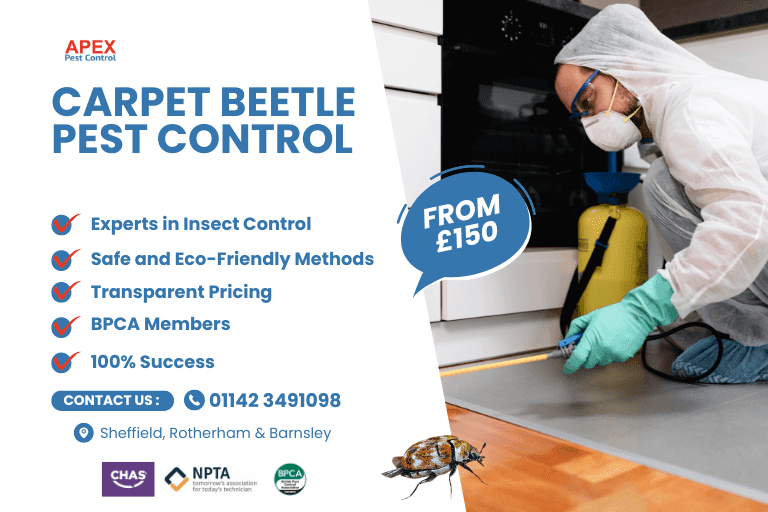


Apex Pest Control Stops Beetle Infestations
Carpet beetle infestations are a silent menace, creeping into our lives unannounced and causing untold damage.
These small, often unnoticed pests, such as the adult carpet beetle and its voracious larvae, feasting on organic matter, natural fibers, and even pet hair, pose a significant threat to our homes.
The varied carpet beetle, sometimes confused with the bed bug or clothes moth, can be particularly destructive.
Unlike the benign presence of an animal like a bear, carpet beetles insidiously invade soft furnishings, carpet edges, and even stored food sources.
Understanding their life cycle, from carpet beetle eggs to the larval stage and then to adult beetles, is crucial in tackling this issue.
At Apex Pest Control, we offer effective carpet beetle pest control strategies, including inspection, cleaning techniques like steam cleaning, and using treatments such as powder to boric acid.
Whether you’re facing a minor annoyance or a full-blown carpet beetle infestation, we will help provide the essential steps and treatment to protect your home from these woolly bears.
Beetle Treatment
Treatment of carpet beetles consists of identifying the extent of the infestation. Checks should be made to ensure that old bird nesting material, wool, fur or similar sources are not harbouring carpet beetle larvae.
Once the carpet beetle infestation is assessed, then treatment will start of the affected areas using a residual insecticide.
When carpets get treated then an insecticide, which will not stain, or otherwise damage your carpet will be selected. For help with pest control for your carpet beetle, Apex Pest Control will remove these bugs.
Our carpet beetle pest control will remove the larvae and prevent the beetle eggs from growing.
Understanding Carpet Beetles
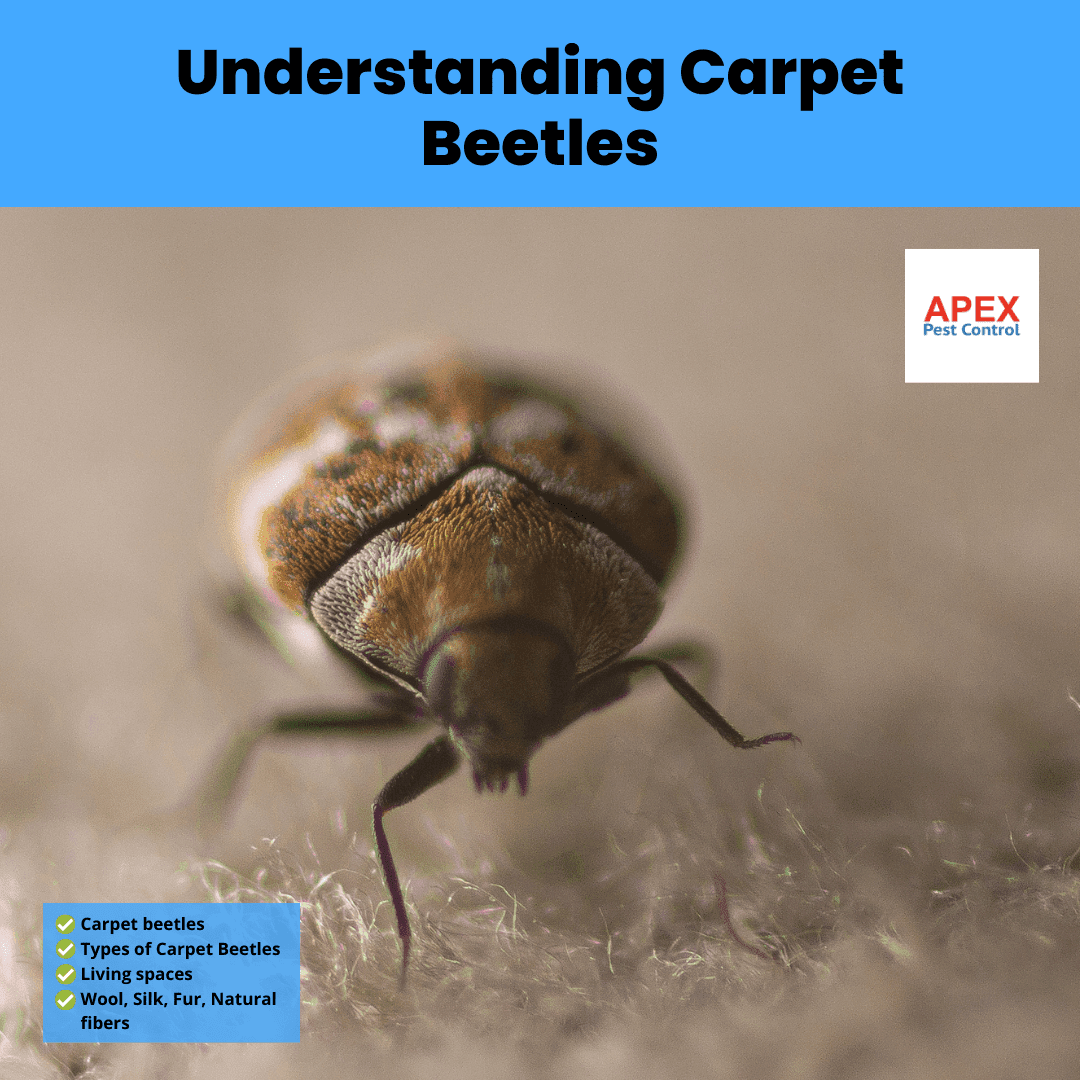
Carpet beetles, a common household pest, encompass various species, including the notorious black carpet beetles and furniture carpet beetles.
These insects, identifiable by their bristly hairs and distinctive larvae stages, often sneak into homes through doors and windows, lured by the accumulations of animal hair or fibres on carpets, rugs, and upholstery.
They pose a significant threat to animal products such as wool, silk, and fur, often found in valuable items like taxidermy mounts, vulnerable furniture, and even bird nests or animal carcasses.
An infestation typically progresses through multiple life stages, beginning with the laying of beetle eggs in susceptible materials.
The larvae, including the common black carpet beetle larvae, are particularly destructive, feeding voraciously on natural fibres and even synthetic fabrics in some cases.
Common signs of an infestation include visible damage to carpets and furniture, sightings of adult and larvae, and accumulations of hair or dead skin that serve as their food sources.
Controlling these pests can be challenging. Methods range from natural approaches like cleaning infested surfaces with vinegar to employing chemical solutions such as carpet beetle killer sprays, beetle powder, and even professional-grade products like smoke bombs or super fumes.
For those seeking to get rid of carpet beetles, it’s essential to understand the types and common species, as their preferences and behaviours can vary.
You can read more on where carpet beetles come from here.
Regular inspection of susceptible items, thorough cleaning of rugs and carpets, and the use of beetle control products
are crucial steps in both preventing and addressing infestations.
The impact of these crawling pests extends beyond just the damage to household items. Their presence in homes, including cold vaults and department stores, can trigger allergies and respiratory issues in sensitive individuals, necessitating prompt and effective beetle control.
Understanding the habits and habitats of these common types of carpet beetles is critical in implementing effective strategies for removal and ensuring the longevity of valuable household items.
Life Cycle of Carpet Beetles
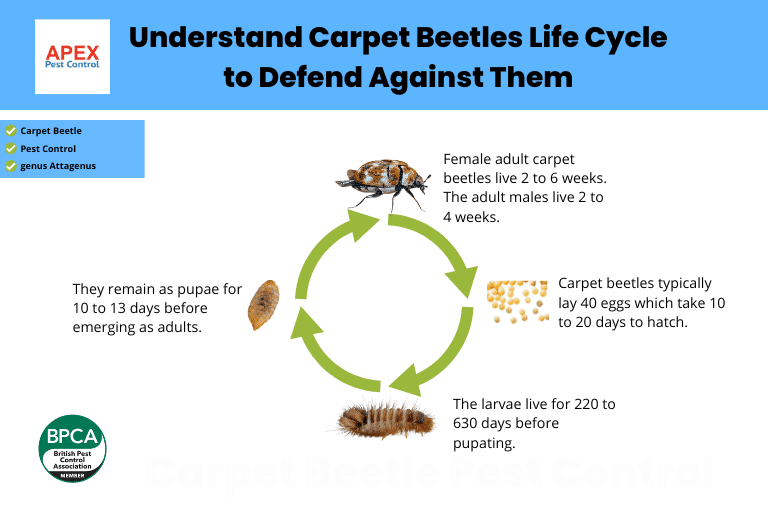
The life cycle of carpet beetles consists of four stages: eggs, larvae, pupae, and adult beetles. The eggs usually lie in dark, hidden areas such as cracks and crevices. After a couple of weeks, the eggs hatch into larvae. These fabric-consuming larvae are responsible for the damage caused by carpet beetles.
They feed on organic materials such as wool, fur, feathers, and silk. The larvae go through several moulting stages before entering the pupal stage.
During this stage, they transform into adult beetles. The adult beetles then emerge from the pupae and begin the process of reproduction.
Habitats and Behaviour of Carpet Beetles
These pests can be found in various environments, including homes, museums, and warehouses. They’re attracted to fabrics and other organic materials, making them a common household pest.
Eggs are laid in dark, undisturbed areas such as closets, attics, and crawl spaces. Once the eggs hatch, the larvae emerge and start feeding on materials like wool, silk, fur, and feathers.
The larvae undergo several moults before reaching adulthood. Adults primarily feed on pollen and nectar and may also infest stored food products.
Understanding the behaviour and preferred food sources of carpet beetles is essential for effective pest control and prevention.
Number of days spent as:
| Egg | 14 – 31 |
| Larvae | 220 – 320 |
| Pupa | 10 – 30 |
| Adult male | 14 – 30 |
| Adult female | 15 – 45 |
Egg to adult at room temperature averages 250-350 days
Damage Caused by Carpet Beetles
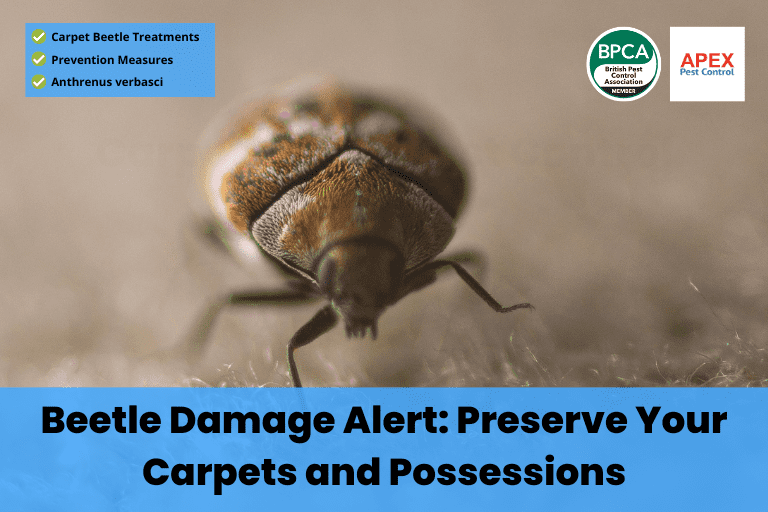
Carpet beetles can have a significant impact on your household items, including carpets, upholstery, and clothing. Not only can they cause physical damage, but they can also pose health risks, as their shed skin and faeces can trigger allergic reactions.
Impact on Household Items
These pests have a strong appetite for natural fibres, such as wool, silk, and cotton. They can chew through fabrics, leaving behind holes and damage that may be irreversible.
Larvae can often be found on furniture, especially if it’s made of natural materials. The larvae shed their skins as they grow, which can also cause damage to furniture.
It’s important to address an infestation promptly to minimise the damage to your household items.
Health Risks Associated with Carpet Beetles
Carpet beetles can pose a risk to your health, especially to those with allergies or asthma. The adult beetles and their larvae can cause skin irritation, leading to redness, itching, and rashes. Moreover, larvae shed their skins and leave behind faecal pellets, which can trigger respiratory
Problems when inhaled.
These pests can also damage your household items, including carpets, clothing, upholstery, and
Even stored food.

Absolutely fantastic service! Tom came out on the day I enquired and was very professional & knowledgable which put my mind at rest. He explained everything throughly and offered advice. I would highly recommend using their services!
Sheffield BranchAnt InfestationSeriously, friendly, effective, quick, what more could you ask for, Thanks Indeed.
For Expert Help Call Today
Preventive Measures Against Carpet Beetles
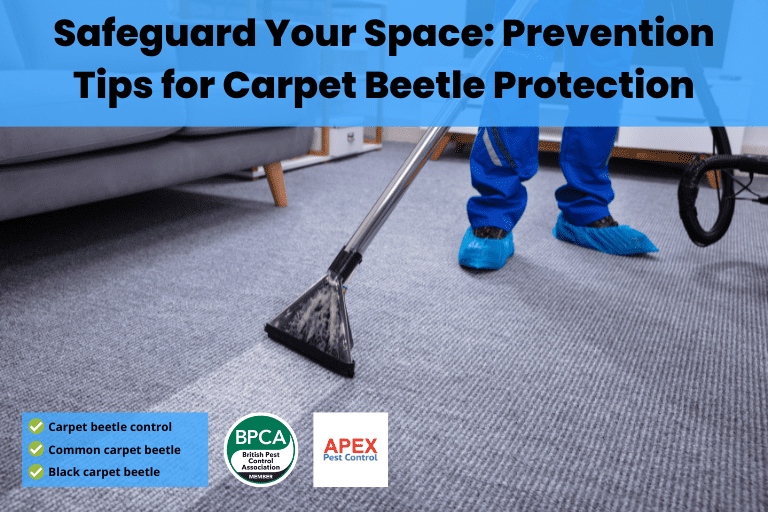
By maintaining cleanliness, securely storing vulnerable items, and shielding your furniture, you can create an environment that’s less inviting to these pests.
Regular Cleaning and Vacuuming
Keep your home free from carpet beetles by regularly cleaning and vacuuming. Regular cleaning and vacuuming are essential preventive measures against carpet beetles.
These pests can infest your carpets, furniture, and clothing, causing damage and frustration. By maintaining a clean and tidy living environment, you can significantly reduce the risk of infestation.
Vacuum your carpets, rugs, and upholstery regularly, paying close attention to areas where pet hair, lint, or food crumbs may accumulate. Be sure to empty the vacuum bag or canister outside to prevent any potential re-infestation.
Additionally, consider steam cleaning your carpets and upholstery periodically to eliminate any hidden eggs or larvae.
Proper Storage of Food and Clothes
Adequate storage is crucial in preventing these pests from accessing their sources of nourishment and breeding grounds. When it comes to food, ensure that all items are stored in airtight containers to minimise the risk of infesting your pantry.
This includes grains, cereals, pet food, and any other dry goods. Regularly check for signs of carpet beetles in your stored clothes. Keep them clean and dry before storing them in sealed containers or vacuum-sealed bags. Avoid storing clothes in damp or humid areas, as this can attract these pests.
Use of Protective Covers for Furniture
Regarding carpet beetle pest control, taking preventive measures is crucial. Protective covers act as a barrier, preventing carpet beetles from accessing your furniture and causing damage.
These covers are specifically designed to fit over your upholstered furniture, providing a physical barrier that keeps carpet beetles away. They’re made of durable materials that aren’t easily penetrated by beetles or their larvae.
Identifying Carpet Beetle Infestation
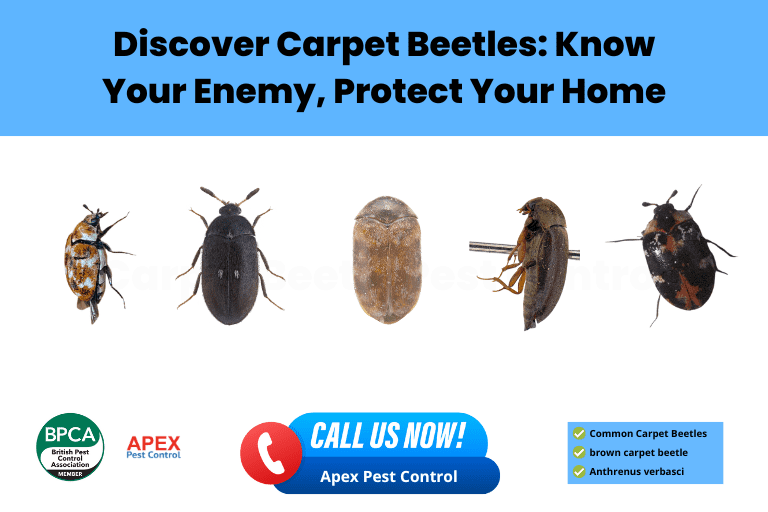
To identify a carpet beetle infestation in your home, keep an eye out for signs such as:
● Small, oval-shaped beetles or larvae crawling on surfaces
● Holes or damage on fabrics and carpets
● Shed skins or faecal pellets
These pests tend to infest common areas like:
● Closets
● Drawers
● Upholstered furniture
Signs of Infestation
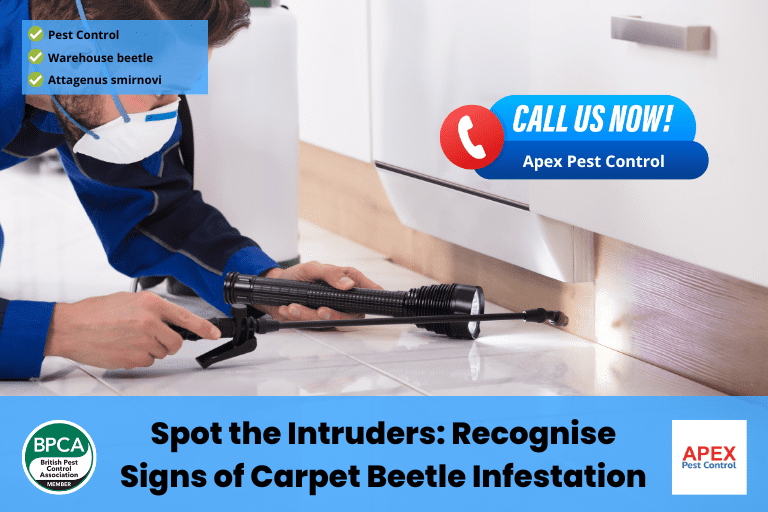
If you notice small, fuzzy larvae crawling around your home, chances are you have an infestation. These tiny creatures are known for their destructive feeding habits, and they can cause significant damage to carpets, upholstery, and other household items.
The signs of an infestation go beyond just seeing the larvae. You may also spot adult carpet beetles, which are small, oval-shaped insects with colourful scales on their bodies.
Another telltale sign is finding shed skins or faecal pellets, which are tiny, granular droppings left behind by the larvae.
If you suspect an infestation, it’s important to take immediate action and seek professional carpet beetle pest control. A thorough carpet beetle treatment can help eliminate the infestation and prevent further damage to your home.
Common Areas of Infestation in Homes
As you continue to investigate an infestation in your home, it’s important to identify the common areas where these pests are known to thrive. Conduct a thorough inspection of your carpets and soft furnishings, as these are prime locations for infestation. Look for signs of damage, such as holes or irregular patterns on carpets and fabric.
Check for the presence of organic matter, such as pet hair or food crumbs, as they are attracted to these food sources. Don’t forget to inspect hidden areas, such as under furniture and in closets. Furthermore, keep an eye out for dead insects as they feed on their remains.
Natural Methods of Carpet Beetle Control
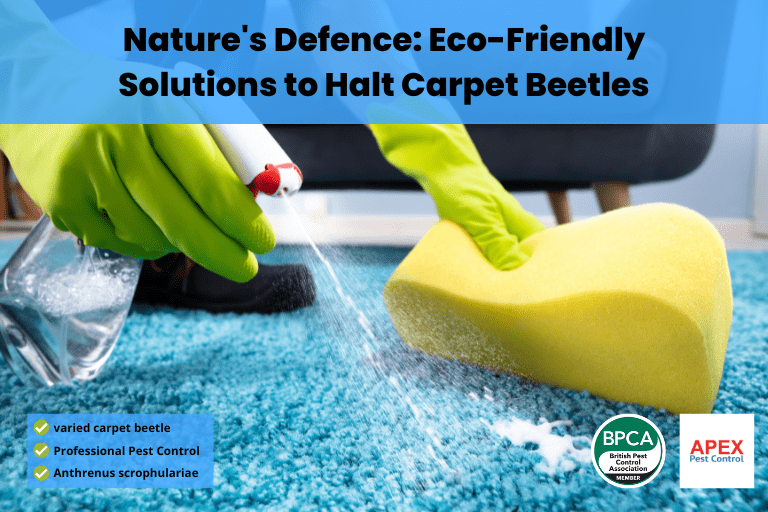
Essential oils, such as lavender or cedarwood, can repel these pests and keep them away from your carpets and furniture.
Diatomaceous earth is another natural option, as it acts as a desiccant and dehydrates the beetles.
Use of Essential Oils
To control carpet beetles naturally, try using essential oils as a pest control method. Essential oils have been proven effective in repelling and eliminating them. Some of the most common essential oils used for this purpose include lavender, peppermint, cedarwood, and eucalyptus.
These oils contain natural compounds that act as insecticides and repellents, making them a safe and environmentally friendly option for carpet beetle control.
To use essential oils, simply dilute a few drops in water and spray the mixture on infested areas. You can also soak cotton balls in the oil and place them in drawers or closets where carpet beetles are commonly found.
Remember to choose essential oils that are contextually relevant and have proven efficacy against carpet beetles. Incorporating essential oils into your pest control routine can help you effectively manage infestations without the use of harmful chemicals.
Use of Diatomaceous Earth
Diatomaceous earth is a natural substance that comes from the fossilized remains of diatoms, a type of algae. It’s a fine powder that can be sprinkled on carpets, furniture, and other infested areas to kill carpet beetles and their larvae.
The sharp edges of diatomaceous earth particles cut through the exoskeleton of the beetles, causing them to dehydrate and die. It’s important to note that diatomaceous earth should be used in a dry form, as moisture can reduce its effectiveness.
To ensure maximum control, reapply the diatomaceous earth every few weeks until the infestation is completely gone. Remember to wear gloves and a mask when applying diatomaceous earth to avoid inhaling the fine particles.
Use of Vinegar and Baking Soda
Are you wondering how vinegar and baking soda can be used to naturally control carpet beetles?
When it comes to pest control, many people prefer using natural methods instead of chemical insecticides. Vinegar and baking soda are two household ingredients that can help you combat infestations without the use of harsh chemicals.
Vinegar is known for its strong acidic properties, which can kill carpet beetles and their larvae upon contact. You can create a vinegar spray by mixing equal parts of vinegar and water in a spray bottle and then applying it to areas where carpet beetles are present.
Baking soda, on the other hand, can be used to eliminate larvae. Sprinkle baking soda onto infested areas and leave it for a few days before vacuuming it up.
Chemical Methods of Carpet Beetle Control
Insecticides are a common option, and they can be applied directly to infested areas or used as a preventive measure.You can also consider using carpet beetle traps, which attract and capture the pests.
Insecticides for Carpet Beetles
You can effectively control carpet beetles by using specific insecticides designed for this purpose. Insecticides are an important tool in carpet beetle pest control as they can target both adult beetles and their larvae.
When choosing an insecticide, look for one that’s labelled specifically for carpet beetle control. These insecticides are formulated to kill carpet beetles at all stages of their life cycle, including eggs and larvae.
Apply the insecticide directly to areas where carpet beetles are present, such as carpets, furniture, and clothing.
Be sure to follow all instructions and safety precautions on the label. Regular and thorough treatment with insecticides can help control infestations and prevent future outbreaks.
Use of Carpet Beetle Traps
To effectively control carpet beetles, utilise carpet beetle traps as a chemical method of control. Traps are an effective way to monitor and reduce carpet beetle populations in your home.
These traps are designed to attract and capture adult beetles, preventing them from laying eggs and further infesting your carpets and fabrics.
The traps work by using pheromones or food based lures to attract the beetles. Once inside the trap, the beetles are unable to escape.
It’s important to place the traps in areas where carpet beetles are commonly found, such as closets, attics, and basements. Regular vacuuming and cleaning of infested materials, coupled with the use of insecticide dust on carpets and fabrics, can help control carpet beetle larvae and prevent future infestations.
Apex Professional Pest Control Services

Professional pest control services offer effective chemical methods for controlling carpet beetles in your home.
Our experts have the knowledge and experience to identify the extent of the infestation and determine the best course of action.
We use specialised chemicals that are specifically designed to target and eliminate carpet beetles. These chemicals are safe for humans and pets when used according to the instructions.
Hiring professionals can save you time and effort when it comes to carpet beetle pest control.
Professional pest control services also provide long-lasting solutions, ensuring that carpet beetles are completely eradicated from your home.
By relying on our expertise, you can rest assured knowing that your carpet beetle problem will be effectively and efficiently addressed.
At Apex Pest Control, we offer to visit you quickly with no call out charge and provide you with the best carpet beetle treatment.
Act now and stop the beetle infestation Call Today!
Pre-Carpet Beetle Treatment
Check out our pre-treatment PDF, click the link: https://apex-pest-control.co.uk/wp-content/uploads/Carpet-Beetle-Steps-to-Get-Rid.pdf
Post-Infestation Cleaning and Restoration
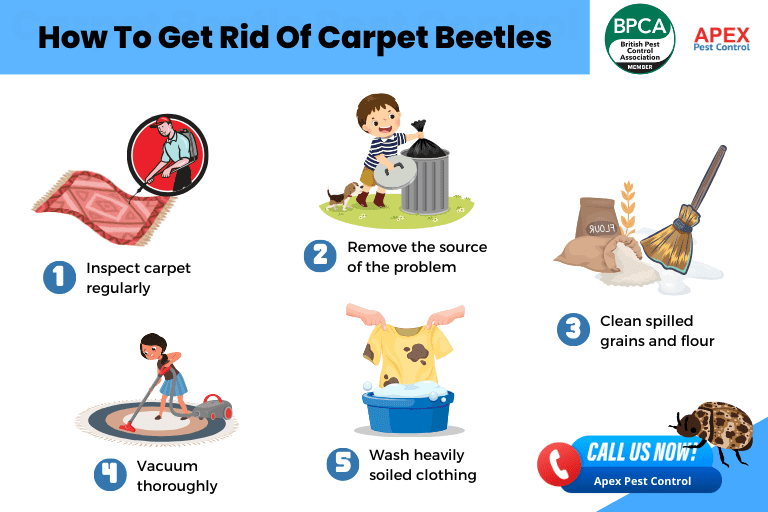
This involves cleaning the infested areas thoroughly to remove all traces of beetles and their larvae. You’ll need to repair any damage caused by the pests, such as replacing damaged carpet or upholstery.
It’s crucial to take preventive measures to avoid future infestations. This can include regular vacuuming to remove any potential food sources for the beetles, sealing cracks and crevices where the beetles could enter your home, and storing fabrics properly to prevent infestations from spreading.
Cleaning Infested Areas
Start by thoroughly vacuuming all infested areas to remove carpet beetle larvae, eggs, and debris. This is an essential step in carpet beetle pest control as it helps eliminate the source of the infestation.
Make sure to pay extra attention to areas where carpet beetles are commonly found, such as carpets, rugs, upholstered furniture, and curtains.
After vacuuming, empty the vacuum cleaner bag or canister outside to prevent any remaining larvae from reinfesting your home.
It’s crucial to clean infested areas using hot water and detergent. This will help remove any remaining eggs or larval skins that may have been missed during vacuuming. Be sure to wash all affected fabrics, including:
- Clothing
- Bedding
- Curtains.
If possible, use the hottest water temperature recommended for the fabric.
Repairing Damage Caused by Carpet Beetles
To repair the damage caused by carpet beetles after an infestation, continue cleaning and restoring the affected areas with the following steps. Thoroughly vacuum the infested areas, paying close attention to carpets, rugs, and upholstered furniture. This will help remove any remaining larvae, adults, or eggs.
Wash all affected fabrics, such as curtains and clothing, in hot water to kill any remaining pests.
For items that can’t be washed, consider dry cleaning or placing them in the freezer for a few days to eliminate any remaining beetles.
Repair any holes or damage in carpets, upholstery, or other fabrics by patching or replacing them.
To prevent future infestations, ensure proper pest control measures are in place, such as regular vacuuming and keeping the affected areas clean and clutter-free.
Preventing Future Infestations
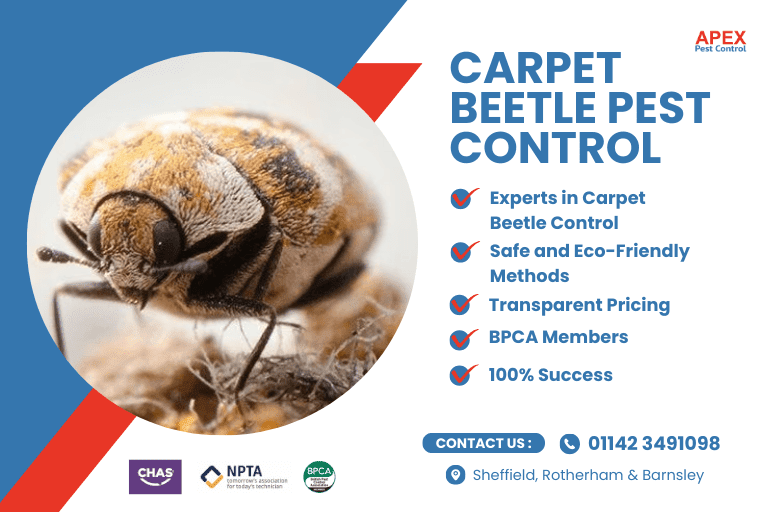
To prevent future infestations after cleaning and restoring areas affected by carpet beetles, you should implement preventative measures such as regular vacuuming and keeping the affected areas clean and clutter-free.
Carpet beetles are attracted to dirt, dust, and debris, so it’s important to maintain cleanliness in your home.
Vacuuming regularly helps to remove any potential food sources for carpet beetles, such as larvae and eggs. Additionally, make sure to clean your carpets, rugs, and upholstery regularly to eliminate any hidden eggs or larvae.
It’s also recommended to use a carpet beetle spray to treat affected areas and prevent reinfestation.
By taking these precautions and practicing proper carpet beetle control, you can significantly reduce the risk of future infestations.
Frequently Asked Questions (FAQs)
How Long Do Carpet Beetles Live?
Carpet beetles can live for several months to a year, depending on environmental conditions. These pests can cause damage to carpets, fabrics, and other household items, so it’s important to address the infestation promptly.
Can Carpet Beetles Fly?
Yes, they can fly. They have wings and are capable of flying short distances. If you’re dealing with an infestation, it’s important to take measures to control the population.
Do Carpet Beetles Bite Humans?
Yes, these pests can bite humans. They have sharp mouthparts that they use to feed on animalbased materials. If you are experiencing bites, it’s important to take steps to control and eliminate the infestation.
Can Carpet Beetles Cause Allergies or Respiratory Issues?
Yes, they can cause allergies and respiratory issues. Their tiny hairs and shed skin can trigger symptoms like sneezing, coughing, and even asthma attacks. It’s important to address the infestation for your well-being.
Are Carpet Beetles Attracted to Certain Colours or Fabrics?
Certain colours and fabrics can indeed attract carpet beetles. They are particularly drawn to bright colours and natural fibres like wool or silk. It’s important to be mindful of these factors when trying to prevent infestations.
| Glossary of Related Terms | |
|---|---|
| Related Term | Definition |
| Carpet Beetle Treatments | Methods and substances used to eliminate or control carpet beetle infestations. |
| Carpet Beetles Infestation | The presence and proliferation of carpet beetles within an environment, typically causing damage. |
| Species of Carpet Beetles | Various types of carpet beetles, each with distinct characteristics and behaviors. |
| Carpet Beetles Infest | The action or process by which carpet beetles invade and establish in a location. |
| Carpet Beetles Eat | The diet of carpet beetles, usually consisting of fabric, fur, or other organic materials. |
| Freeze Carpet Beetles | A method of exterminating carpet beetles by exposing them to extremely low temperatures. |
| Notice Carpet Beetles | Identifying signs of carpet beetle presence, such as damaged fabrics or visible insects. |
| Carpet Beetle Facts | Essential information and characteristics about carpet beetles. |
| Larvae Feed | The feeding behavior of carpet beetle larvae, which typically involves consuming organic materials. |
| Larval Food | The preferred diet or food sources for carpet beetle larvae. |
| Egg Laying Sites | Preferred locations where carpet beetles lay their eggs, usually in hidden or undisturbed areas. |
Contact Us
- Apex Pest Control
- 54 Baxter Dr, Birley Carr, Sheffield, S6 1GH
- Local Branch
Members of

Follow Us
